www.sageventure.com.
If you have a question, I am glad to help the best I can and I usually respond quickly. My contact email is TheHiker@SageVenture.com.
_________________________________________________________________________________
Token Value.
Many of the swastika tokens are very common and are not worth more than $20 to $30 in uncirculated condition; in used condition their worth is between $5 and $15. Of course there are exceptions but for the most part, I recommend that you are careful with your bidding on places like eBay. (The "Value" link-tab to the right is for "Good Value Club"; not for token value.)
Swastika.
A great many good luck tokens were made from the 1910's through the 1930's. Until World War II, the swastika was one of the significant symbols of good luck and was used on many tokens during this period. Of course, the German use of the swastika changed that and it is no longer used as a positive symbol. The swastika was also used in scouting and I have written about that here - www.worldscoutingmuseum.org/swastikas.shtml. Within the swastika, there are four symbols. The first three are easy; horseshoe, four leave clover and wishbone. It is the fourth set of three symbols that exist on most of these tokens that seems to be unclear. I used to believe that the symbols were runic characters but after being contacted by David Ruckser who believed they were hieroglyphs, I did research in that area and now concur with David.
Egyptian Hieroglyphs.
For most tokens, there are three symbols but not always the same three. One is sometimes vertically inverted. I understand the hieroglyphs to be:

Irrigation canals also used for "the two lands." (This one does not match well but it is the best match I can find at this time.)
Forearm with bread loaf meaning "to give"
Bread bun (or feminine) or
ideogram for basket: master, lord.
- en.wikipedia.org/wiki/List_of_Egyptian_hieroglyphs_by_common_name:_A-L
- en.wikipedia.org/wiki/List_of_Egyptian_hieroglyphs_by_common_name:_M-Z
An Egyptian coin dealer, Ala'a Farag (Al), provided me with this interpretation of the hieroglyphs: "it's the story of making food from bringing the water to the field, to agriculture, and making bread for people to feed."
Al went out of his way to be helpful so if you are interested in Egyptian coins, please visit his eBay store.
Token Classification.
As an attempt to classify the tokens and make it easier for viewing, I have categorized the tokens into five groups. My groups are:
- Scout / Excelsior tokens - These are tokens issued by the Excelsior Shoe Co. that refer to "Shoe for Boys" or "Boy Scouts" and has a rider on the obverse
- Worcester Salt
- Those not in the above categories that say on the reverse, "Membership Emblem of the Don't Worry Club."
- Those not in the first two categories that say on the reverse, "Membership in the Good Value Club."
- All Other
- A horseshoe in quadrant 1;
- A four leaf clover in quadrant 2;
- A wishbone in quadrant 3; and
- Three hieroglyphs in quadrant 4.
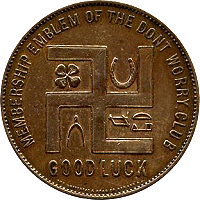
Common reverse
Type L1
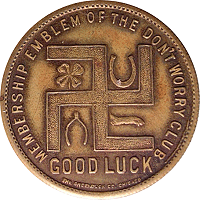
Rabbit's foot in quadrant 4
Type L2
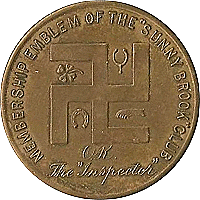
Symbols in quadrant 1 and 3
are exchanged and
Rabbit's foot in quadrant 4
Type L3
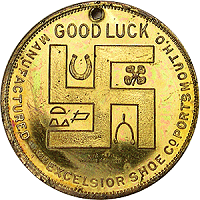
Common reverse
Type R1
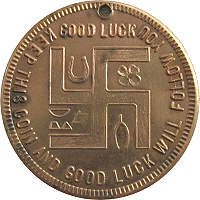
D symbol in quadrant 4
is flipped.
Type R2

Symbols in quadrant 2 and 4
are exchanged.
Type R3

Symbols in each quadrant
are upside down.
Type R4
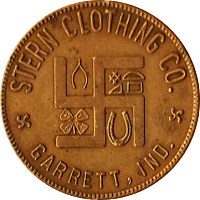
Symbols in quadrant 1 and 3
are exchanged, and symbols in
quadrant 2 and 4 are exchanged.
Type R5

Symbols in quadrant 1 and 3
are exchanged, and symbols in
quadrant 2 and 4 are exchanged.
And symbols are upside down.
Type R6
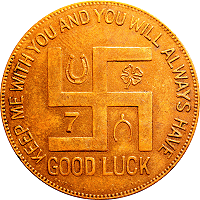
Similar to the common reverse
except a "7" in is quadrant 4.
Type R7
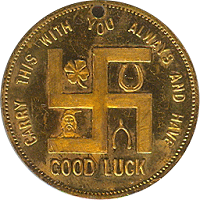
Symbols in quadrant 1 and 2
are exchanged, and symbol in
quadrant 4 is a Master-like figure
Type R8
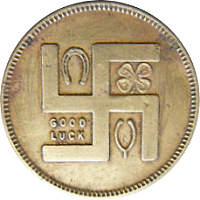
Similar to type R4
except "Good Luck" in is quadrant 4.
Type R9
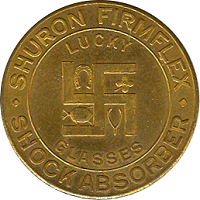
Similar to Type R4
except "beetle" in is quadrant 4.
Type R10
Most tokens are about 32-33 mm but some are in the 25-26 mm range. The smaller ones are shown as smaller. The tokens have also been made with various medals; bronze, brass, aluminum, steel, etc. However, I have not focused on the metal types and for the most part will not include that information.
If you have a token that is not listed as would like to share it, I'd appreciate a nice scan and I will gladly let others know it came from you. To do so, just email it to Craig Murray at TheHiker@SageVenture.com. Thank you.
Swastika References: